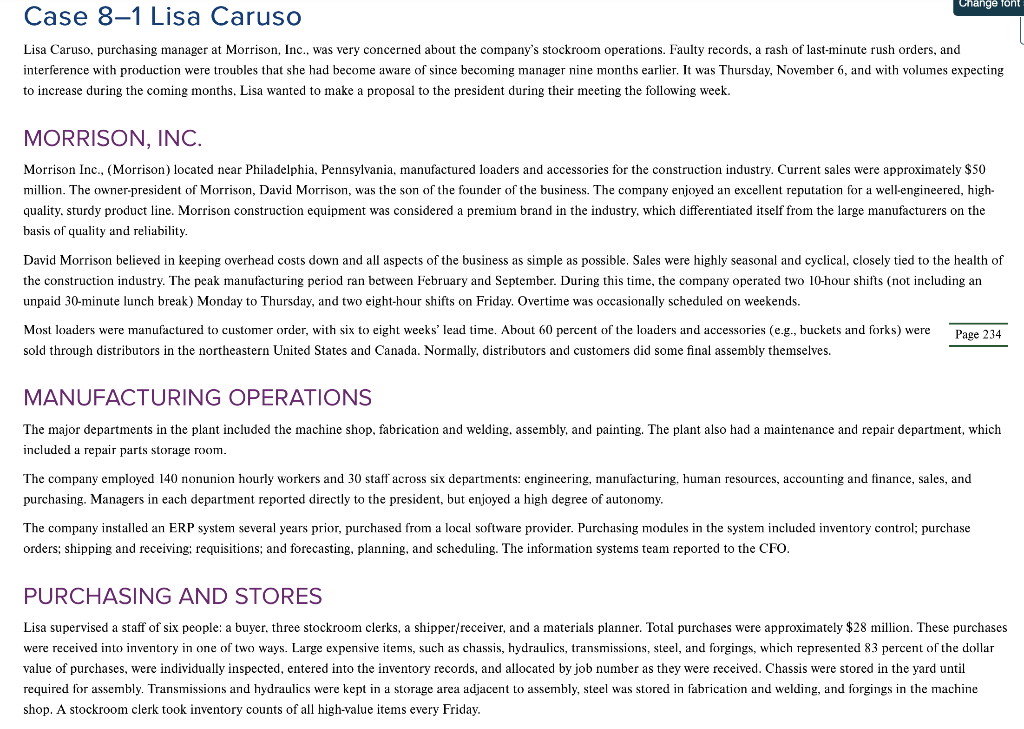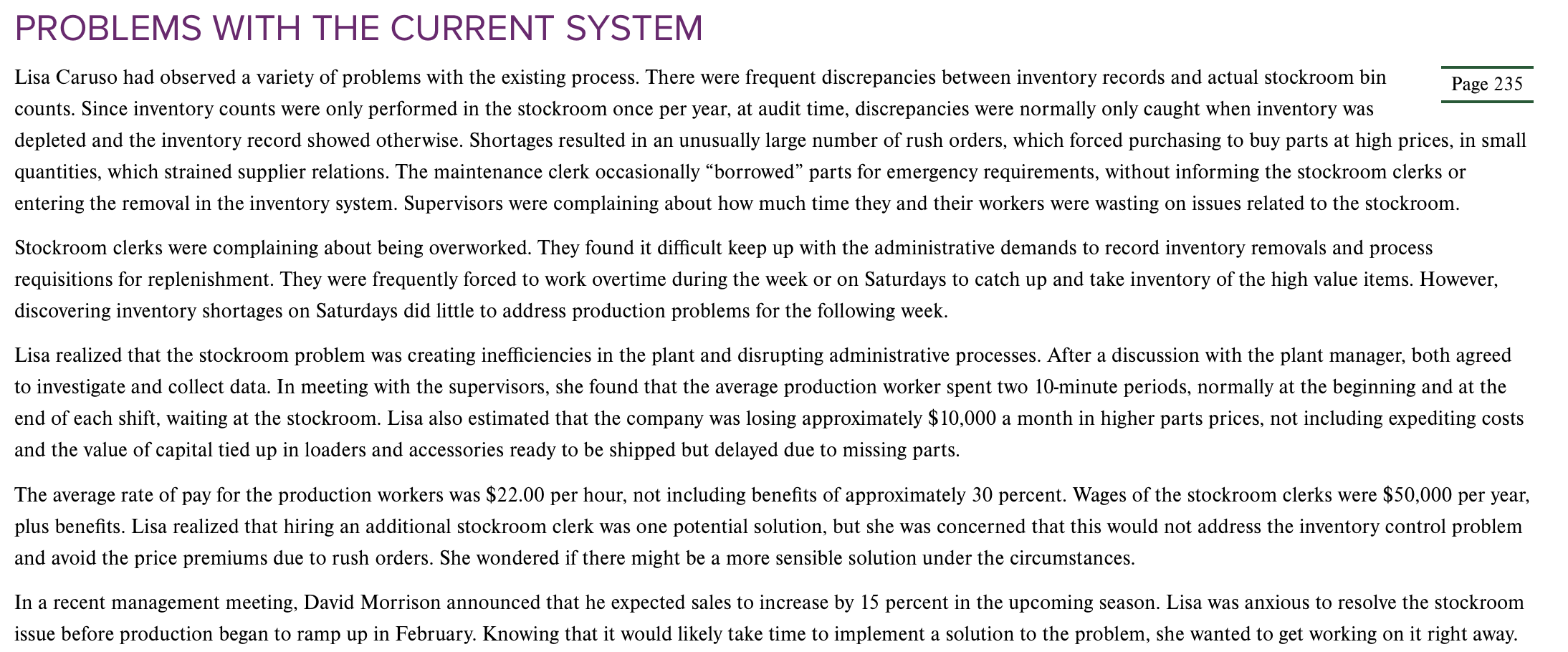Thank you ahead of time!
Questions:
1. What are the problems in the stockroom and what is causing them? 2. Why are stockroom operations step-up under the current system? What are the objectives? 3. How much money is Morrison losing because of the problems in the stockroom? What the cost versus the benefit?
Reading:



Lisa Caruso, purchasing manager at Morrison, Inc., was very concerned about the company's stockroom operations. Faulty records, a rash of last-minute rush orders, and interference with production were troubles that she had become aware of since becoming manager nine months earlier. It was Thursday, November 6 , and with volumes expecting to increase during the coming months. Lisa wanted to make a proposal to the president during their meeting the following week. MORRISON, INC. Morrison Inc., (Morrison) located near Philadelphia, Pennsylvania, manufactured loaders and accessories for the construction industry. Current sales were approximately $50 million. The owner-president of Morrison, David Morrison, was the son of the founder of the business. The company enjoyed an excellent reputation for a well-engineered, highquality. sturdy product line. Morrison construction equipment was considered a premium brand in the industry, which differentiated itself from the large manufacturers on the basis of quality and reliability. David Morrison believed in keeping overhead costs down and all aspects of the business as simple as possible. Sales were highly seasonal and cyclical, closely tied to the health of the construction industry. The peak manufacturing period ran between February and September. During this time, the company operated two 10-hour shifts (not including an unpaid 30-minute lunch break) Monday to Thursday, and two eight-hour shifts on Friday. Overtime was occasionally scheduled on weekends. Most loaders were manufactured to customer order, with six to eight weeks' lead time. About 60 percent of the loaders and accessories (e.g., buckets and forks) were sold through distributors in the northeastern United States and Canada. Normally, distributors and customers did some final assembly themselves. MANUFACTURING OPERATIONS The major departments in the plant included the machine shop, fabrication and welding, assembly, and painting. The plant also had a maintenance and repair department, which included a repair parts storage room. The company employed 140 nonunion hourly workers and 30 staff across six departments: engineering, manufacturing, human resources, accounting and finance, sales, and purchasing. Managers in each department reported directly to the president, but enjoyed a high degree of autonomy. The company installed an ERP system several years prior, purchased from a local software provider. Purchasing modules in the system included inventory control; purchase orders; shipping and receiving; requisitions; and forecasting, planning, and scheduling. The information systems team reported to the CFO. PURCHASING AND STORES Lisa supervised a staff of six people: a buyer. three stockroom clerks, a shipper/receiver, and a materials planner. Total purchases were approximately $28 million. These purchases were received into inventory in one of two ways. Large expensive items, such as chassis, hydraulics, transmissions, steel, and forgings, which represented 83 percent of the dollar value of purchases, were individually inspected, entered into the inventory records, and allocated by job number as they were received. Chassis were stored in the yard until required for assembly. Transmissions and hydraulics were kept in a storage area adjacent to assembly, steel was stored in fabrication and welding, and forgings in the machine shop. A stockroom clerk took inventory counts of all high-value items every Friday. The remaining items were sent from the receiving dock to the stockroom. This locked area contained 13,000 different parts, including all kinds of nuts and bolts, rubberized parts, gaskets, hoses, lights, and welding and machine shop supplies. It was staffed by three clerks. Normally one clerk worked days from 8:30 a.m. to 5:00 p.m., and another from 5:00 p.m. to 1:30 a.m. The third clerk would work either the first or second shift, depending on how busy it was. Stores operated on a variation of a min/max system, with total inventory ranging from a low of $1.2 million to a high of $3 million. Order quantities varied on the time of year. In February, March, and April, purchasing paid particular attention to peak season requirements and the possibility of quantity discounts. Near the end of the season, however, Lisa was anxious to avoid carrying excess inventory and would try to order only in sufficient quantities to meet requirements until September. Past usage was used as a guide when determining order quantities. A TYPICAL DAY'S OPERATION The first production shift started at 7:00 a.m. The production supervisors, whose employee access cards opened the locked stockroom, collected and distributed trays to the workers, prepared the previous evening, with their parts requirements for the shift. If the tray was not prepared or incomplete, the supervisor would take the necessary items, often without bothering to record the removal in the inventory system. At 8:30 a.m., the stockroom clerk opened the stores areas, handled requisitions as they arose, and, as time permitted, put away the parts trays from the previous night's shift and began assembly of new parts trays for the second shift that day. In addition, the stockroom clerks were required to assemble kits of parts for finished loaders leaving the plant, which would be used by customers or distributors for final assembly. Normally, these kits were required to be available between 3;00 p.m. and 6:00 p.m. As shortages were noted in the stockroom bins, requisitions were completed and sent to the buyer. All workers were required to return their parts trays to the stockroom at the end of the shift. This allowed unused parts to be returned to inventory and workers were held accountable for parts usage. Workers were also expected to order parts requirements for the following day at the end of their shift. Since it was not always clear what such requirements might be, because progress on the next shift could only be estimated, it was not unusual for workers to over- or under-order parts requirements. The second production shift started at 5:30 p.m., 30 minutes after the second stockroom shift started. Parts trays were handed out to incoming workers and the stockroom continued the same routine as on the first shift. At 1:30 a.m. the stockroom clerk went off duty. while production continued until 3:30 a.m. The supervisors on the night shift opened the stockroom as required during the absence of the stockroom clerk, and, before locking up the plant at the end of the shift, they returned the parts trays and left lists specifying requirements for the shift the following evening. PROBLEMS WITH THE CURRENT SYSTEM Lisa Caruso had observed a variety of problems with the existing process. There were frequent discrepancies between inventory records and actual stockroom bin counts. Since inventory counts were only performed in the stockroom once per year, at audit time, discrepancies were normally only caught when inventory was depleted and the inventory record showed otherwise. Shortages resulted in an unusually large number of rush orders, which forced purchasing to buy parts at high prices, in small quantities, which strained supplier relations. The maintenance clerk occasionally "borrowed" parts for emergency requirements, without informing the stockroom clerks or entering the removal in the inventory system. Supervisors were complaining about how much time they and their workers were wasting on issues related to the stockroom. Stockroom clerks were complaining about being overworked. They found it difficult keep up with the administrative demands to record inventory removals and process requisitions for replenishment. They were frequently forced to work overtime during the week or on Saturdays to catch up and take inventory of the high value items. However, discovering inventory shortages on Saturdays did little to address production problems for the following week. PROBLEMS WITH THE CURRENT SYSTEM Lisa Caruso had observed a variety of problems with the existing process. There were frequent discrepancies between inventory records and actual stockroom bin counts. Since inventory counts were only performed in the stockroom once per year, at audit time, discrepancies were normally only caught when inventory was depleted and the inventory record showed otherwise. Shortages resulted in an unusually large number of rush orders, which forced purchasing to buy parts at high prices, in small quantities, which strained supplier relations. The maintenance clerk occasionally "borrowed" parts for emergency requirements, without informing the stockroom clerks or entering the removal in the inventory system. Supervisors were complaining about how much time they and their workers were wasting on issues related to the stockroom. Stockroom clerks were complaining about being overworked. They found it difficult keep up with the administrative demands to record inventory removals and process requisitions for replenishment. They were frequently forced to work overtime during the week or on Saturdays to catch up and take inventory of the high value items. However, discovering inventory shortages on Saturdays did little to address production problems for the following week. Lisa realized that the stockroom problem was creating inefficiencies in the plant and disrupting administrative processes. After a discussion with the plant manager, both agreed to investigate and collect data. In meeting with the supervisors, she found that the average production worker spent two 10-minute periods, normally at the beginning and at the end of each shift, waiting at the stockroom. Lisa also estimated that the company was losing approximately $10,000 a month in higher parts prices, not including expediting costs and the value of capital tied up in loaders and accessories ready to be shipped but delayed due to missing parts. The average rate of pay for the production workers was $22.00 per hour, not including benefits of approximately 30 percent. Wages of the stockroom clerks were $50,000 per year, plus benefits. Lisa realized that hiring an additional stockroom clerk was one potential solution, but she was concerned that this would not address the inventory control problem and avoid the price premiums due to rush orders. She wondered if there might be a more sensible solution under the circumstances. In a recent management meeting, David Morrison announced that he expected sales to increase by 15 percent in the upcoming season. Lisa was anxious to resolve the stockroom issue before production began to ramp up in February. Knowing that it would likely take time to implement a solution to the problem, she wanted to get working on it right away









